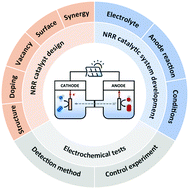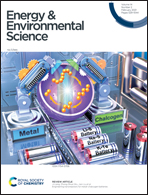Recent progress in electrochemical synthesis of ammonia from nitrogen: strategies to improve the catalytic activity and selectivity
Abstract
The modern ammonia synthesis industry founded by Haber–Bosch in 1913 has successfully altered the history of food production, fed explosive population growth, and laid the foundation of heterogeneous catalysis and chemical engineering as well. However, its reliance on fossil fuels for reactant H2 production consumes 1–3% of the world's electric energy and 2–5% of the world's natural gas, accompanied by more than 400 million tons of CO2 emission annually. Making use of water as the proton source and electric energy to drive the ammonia synthesis reaction will reduce the fossil fuel consumption and CO2 emission and is thus regarded as a green and sustainable alternative to the conventional Haber–Bosch process. To date, some excellent reviews on electrochemical ammonia synthesis have been published, but most of them were organized according to the type of catalyst. A systematic summary of the performance-improving strategies of the electrocatalyst for ammonia synthesis is rarely reported and therefore highly desirable. In this review, the nitrogen reduction reaction mechanisms and recent theoretical advances are briefly outlined first. Then, strategies for both reactivity and selectivity enhancement of catalysts and catalytic systems are methodically discussed. Last, criteria for the electrochemical nitrogen reduction reaction, ammonia quantification methods, and an outlook for further research are also concluded. This review aims to provide systematic and concise guidance for the design of highly efficient and selective electrochemical ammonia synthesis systems.



 Please wait while we load your content...
Please wait while we load your content...